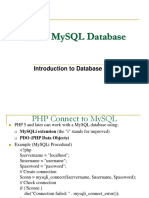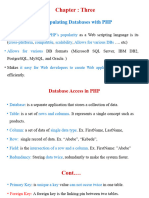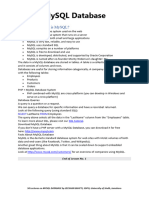0% found this document useful (0 votes)
12 views33 pagesChapter 4-PHP
This document provides an overview of database-driven websites using PHP, particularly focusing on MySQL. It outlines the steps for connecting to a database, creating databases and tables, and inserting and selecting data using MySQLi and PDO methods. The document also discusses the advantages of using MySQLi versus PDO for database interactions.
Uploaded by
yibeltalmesfin278Copyright
© © All Rights Reserved
We take content rights seriously. If you suspect this is your content, claim it here.
Available Formats
Download as PPTX, PDF, TXT or read online on Scribd
0% found this document useful (0 votes)
12 views33 pagesChapter 4-PHP
This document provides an overview of database-driven websites using PHP, particularly focusing on MySQL. It outlines the steps for connecting to a database, creating databases and tables, and inserting and selecting data using MySQLi and PDO methods. The document also discusses the advantages of using MySQLi versus PDO for database interactions.
Uploaded by
yibeltalmesfin278Copyright
© © All Rights Reserved
We take content rights seriously. If you suspect this is your content, claim it here.
Available Formats
Download as PPTX, PDF, TXT or read online on Scribd
/ 33

























































































